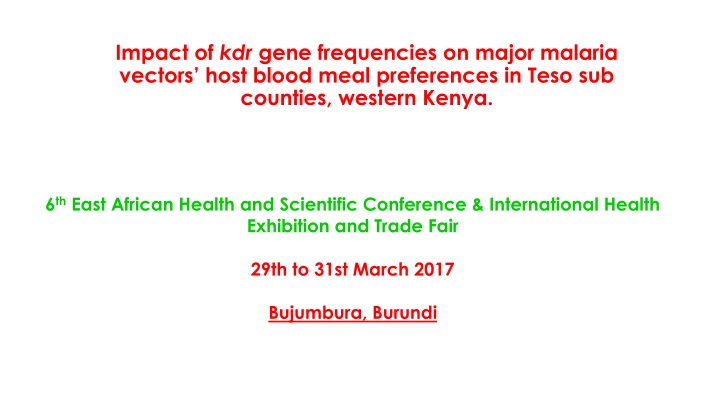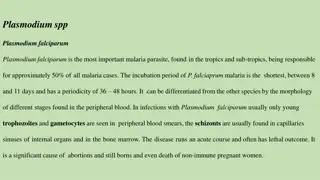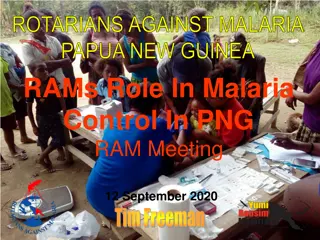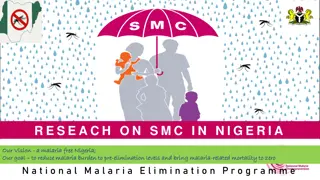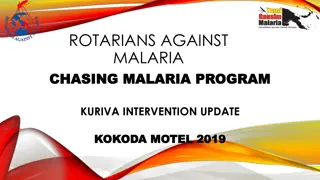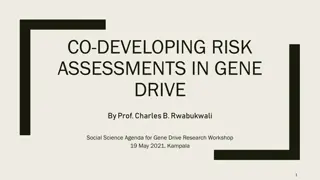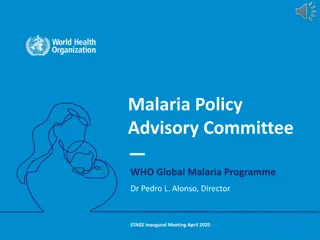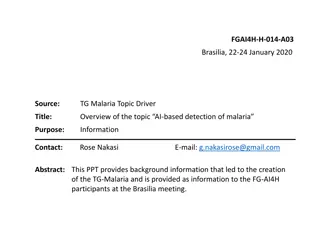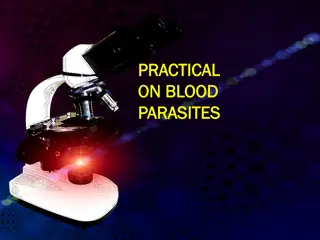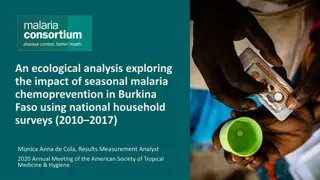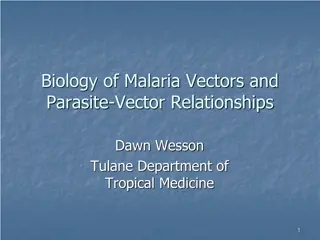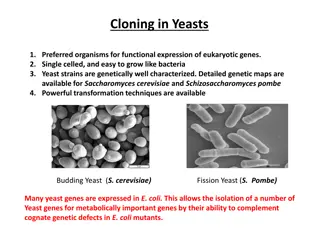Impact of KDR Gene Frequencies on Malaria Vectors' Blood Meal Preferences
This study delves into the impact of KDR gene frequencies on major malaria vectors' host blood meal preferences in Teso sub-counties, Western Kenya. It explores insecticide resistance and its implications for malaria transmission potential among these vectors, focusing on Anopheles gambiae sensu lato. The research sheds light on the challenges faced in malaria vector control due to evolving insecticide resistance, necessitating surveillance and monitoring efforts to combat the disease effectively.
Download Presentation

Please find below an Image/Link to download the presentation.
The content on the website is provided AS IS for your information and personal use only. It may not be sold, licensed, or shared on other websites without obtaining consent from the author.If you encounter any issues during the download, it is possible that the publisher has removed the file from their server.
You are allowed to download the files provided on this website for personal or commercial use, subject to the condition that they are used lawfully. All files are the property of their respective owners.
The content on the website is provided AS IS for your information and personal use only. It may not be sold, licensed, or shared on other websites without obtaining consent from the author.
E N D
Presentation Transcript
Impact of kdr gene frequencies on major malaria vectors host blood meal preferences in Teso sub counties, western Kenya. 6th East African Health and Scientific Conference & International Health Exhibition and Trade Fair 29th to 31st March 2017 Bujumbura, Burundi
Authors & their institutional affiliation Githinji Edward *1&2, Irungu Lucy2, Ndegwa Paul2, Atieli Francis3, Kemei Brigid3, Machani Maxwell3, Amito Richard3, Murima Paul4, Ombok Maurice3, Wanjoya Antony5, Mbogo Charles6& Mathenge Evan1 1. Eastern & Southern Africa Centre for International Parasite Control (ESACIPAC), KEMRI Nairobi University of Nairobi Centre for Global Health Research (CGHR), KEMRI Kisumu Vector-borne Disease Control Unit Ministry of Health, Nairobi Jomo Kenyatta University of Agriculture & Training JKUAT Juja, Nairobi KEMRI-Wellcome Trust Research Programme, Nairobi 2. 3. 4. 5. 6.
Back ground information Malaria is a leading cause of morbidity & mortality Malaria vector control relies heavily on insecticide-based interventions (IRS & LLINs) The efficacy of these tools depends on the feeding behaviour of mosquitoes. Insecticide resistance among major vectors is emerging as a major threat Insecticide resistance management programmes to be optimized (Kenya National Malaria Strategy 2009 -2017) 4 major types of IR: Target-site , Metabolic, Behavioural & Cuticular Current understanding of the evolution of IR results from mutation of the target sites (kdr or super-kdr) or from overexpression of GSTs, esterases & cytochrome P450s An. gambiae s.s & An. funestus are highly endophagic & anthropophagic while An. arabiensis is zoophilic but endophagic (Githeko et al., 1994).
Problem statement Malaria remains a major public health problem in Kenya, accounts for an 18% of outpatient consultations & 10% of hospital admissions Many insecticides extensively used to control domestic & agricultural pests, exerting more insecticide resistance selection pressure. Cross resistance cause vector populations to develop resistance very rapidly to newly introduced insecticides Malaria vector control rely heavily on a single safe insecticide class: pyrethroids Despite the huge investments in LLINs and IRS roll out Need for surveillance, monitoring & evaluation while operational research is vital for tracking the progress of malaria prevention & control activities
General Objective: Insecticide resistance & it s impact on malaria transmission potential among the major vectors in Teso sub counties, western Kenya Specific Objective The crossectional study aimed at determining blood meal preferences in Anopheles gambiae sensu lato in areas with & areas without insecticide resistance in Teso sub-counties, western Kenya.
Study site: Teso North & Teso South sub-counties Lake Victoria Four divisions ; Amagoro, Amukura, Angurai & Chakol Population at risk in Teso is 252, 884 people among whom 51,424 are aged between 0&4 years Lake Victoria 6
Methods & materials Mosquito larvae sampled & reared to adults. 3-5 days-old female mosquitoes were exposed to insecticides (permethrin, deltamethrin & bendiocarb) Adult mosquitoes also sampled (indoor & outdoor) by human landing catch method, indoor aspiration, pyrethrum spray catch, window exit trap & outdoor pot collection methods Blood meal ELISA, Species ID PCR, Blood meal & kdr East gene PCR performed Kdr East TaqMan assay where FAM & HEX reporting dyes detected mutant allele & wild type respectively
Larval sampling DNA extraction, sometimes blood meal ELISA, species , blood meal & Kdr PCR; Field mosquito larvae collections and Laboratory work
Percentages of homozygous & heterozygous resistance alleles in Teso sub-county western Kenya n = 560; 112 samples@cluster done kdr assay 93.4 91.9 100 90 77.6 76.1 80 70 57.8 % of alleles 60 LL 50 SS 40 33.3 LS 30 17.8 20 13.8 10.1 8.9 4.6 4.5 10 4 3.6 2.6 0 Kaliwa Odioi Akiriamasit Kengatunyi Rwatama Clusters or Sub-locations
Impact of insecticide resistance on endophagic & endophilic behavior in female Anopheles mosquitoes; Pyrethrum Spray Catch (n = 338)
Discussion Homozygous LL & heterozygous LS allelic vectors had significantly higher affinity for bovine blood while SS allelic vectors had significantly higher affinity for human rather than bovine blood (p<0.05) Resistant malaria vectors were more anthropophagic than zoophagic Susceptible mosquitoes preferred bovine blood meal the most An. funestus had a higher affinity for bovine blood meal than human s and pig s Blood meal preference was dependent on resistance status, species & location Host preference is normally affected by a myriad of extrinsic & intrinsic factors. Inherent factors are determined by genetic selection even due to insecticidal selection pressure
Conclusion Resistance genes may be enhancing or depressing anthropozoophagic behavior in malaria vectors hence influencing transmission levels Recommendation Zoo-prophylaxis may reduce plasmodium transmission rates by anthropozoophagic vectors Continued monitoring of impact of insecticide resistance genes in vectors, on their malaria transmission potential to inform Insecticide Resistance Management Programmes
Acknowledgments 1. UoN 2. NACOSTI 3. KEMRI / WHO-BILL & Melinda Gates IR PROJECT 4. Supervisors 5. Family 6. Friends 7. Colleagues 8. God Almighty
